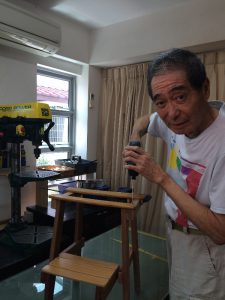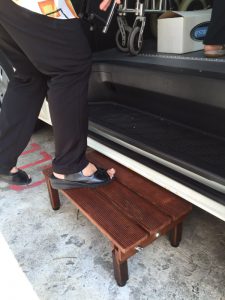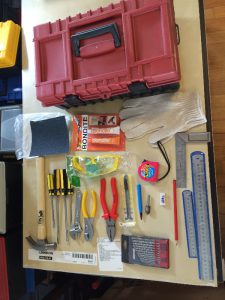Cultivating a DIY culture
One man is on a mission. Though he hasn’t been successful yet, he is hoping to change the throwaway culture that exists and encourage people to repair, reuse and recycle.
BY: Eleanor Yap
Tao Hai Sin is on a mission – to cultivate a DIY culture in Singapore. The 73-year-old grandfather of four said, “By doing DIY projects, you get to repair, reuse and recycle things instead of throwing it out and buying new ones, which in the end becomes quite wasteful.” When he is free, you can find him tinkering in his 80sqm workshop in his home, which is filled with tools, equipment, accessories and materials.
Since actively pursuing this hobby after he retired in 1999, after 35 years in engineering and managing factories producing various products, he has recently made a few things for others, which he has done for free. A church van, that is often used to ferry less mobile seniors around, had a step that was too high for them to get up and down comfortably. So he made a “step” with four legs, with two side legs that can pivot to accommodate sloping or uneven ground levels, so all four legs touch the ground. He helped a friend repair a teak bookshelf by joining together the shelves that were broken apart. For his church, he made a simple wooden box to hide the wires connecting the speakers to the new electronic organ so that they were hidden and less unsightly.
For a beneficiary of non-profit organisation, he helped replace the frames and hinges of a family’s five-door kitchen cabinet. “There are very few volunteers who can help with this type of work. It took me four-man hours in my workshop to prepare the frame. A friend and I took another two hours at the site for the installation – a total of eight-man hours. A lot of people don’t understand that these carpentry works can take a lot of time,” explained Hai Sin.
He also helped design an aluminium ramp to enable a friend’s wheelchair-bound friend to enter and exit the bathroom. He has even made a “transformer” chair that morphs into a four-step ladder. Picking up his skills from his friend in Australia as well as from the Internet, Hai Sin said, “I get great satisfaction from making something functional and usable that cannot be readily purchased.”
Building a DIY Culture
Asked why he hasn’t earned some income from his work, he shared, “It was not my intention to make money, but it is often times difficult to place a value on the cost of materials, time and effort spent, and to come to a price that both parties can agree on. What people are willing to pay for is often quite different from what is enough for a reasonable income.”
He added: “I want to create a DIY culture to encourage people to learn the skills to repair and make simple things, to encourage those who have the skill to do more and to encourage society to understand that they need to pay for such a skill. Furthermore, fewer and fewer people are doing DIY as they don’t have a place at home to store their tools, materials and equipment. They might have basic skills but can’t improve on those skills as they don’t have a chance to practice them,” said Hai Sin, who explained that a large portion of Singaporeans now live in flats that don’t even have enough room to store their household items!
Sadly, people don’t seem to value carpentry work these days. “The Singapore mentality is that DIY is menial work that you can easily get other people to do it for a small fee and it’s not a necessary skill to pick up for yourself.” But he pointed out that this attitude is incorrect, as one should have some basic skills that are useful for home care.
“Besides, the value of learning a new skill – whether carpentry, sewing or changing light bulbs – it is very meaningful and can bring a huge sense of satisfaction.” He said that for adults, DIY and repairing broken objects in the home could be an environmentally-sustainable act, while saving on the cost of buying a new item. Children who are taught DIY can learn the values of frugality, creativity and self-confidence. “There are no age nor gender restrictions in picking up DIY skills. Acquiring DIY skills is wonderful for personal growth as it involves problem-solving and creating something with your own hands.”
Hai Sin added: “It wasn’t so long ago that clothes were made by hand, carpenters made cupboards and tinkerers would give new life to broken cooking pots that lost a handle. With factories and mass production, many things have become much more affordable, but it has also created a ‘broken, then throw away’ mentality. It may be easier and cheaper to pay for a manufactured item, but it is much more fulfilling and engaging to make it yourself!” He further lamented that people in Singapore normally want to move to a new home every six or seven years because things begin to fall apart in their old homes.
The most common technicians that we employ to fix things in our homes are electricians for electrical problems, plumbers for leaking problems and locksmiths for when we are locked out of our homes, he said. “While some jobs are best left to the professionals, there are simple fix-it jobs that can easily be mended like a kitchen cabinet that is dangling or loose, a wobbly chair or the soles of a pair of shoes that are opening up. People tend to just live with them and don’t get them fixed until they break.”
His efforts to get various people to hold workshops on DIY work has since bore some fruit recently as U 3rd Age (U3A) will be having him speak in June about DIY. “There is no DIY future in Singapore unless certain changes take place, like conducting classes in school that teach basic DIY skills to students, and communal workshops with work benches and tools where people can go and do their repairs for free or for a small fee. I find it sad that we are so wasteful as a society.”
** The free U3A session with Hai Sin on “The Joy of DIY” will be held on June 15 from 7pm to 9pm at 10-Square, Orchard Centre, Level 10, 181 Orchard Rd. To register, go to: u3rdage.eventbrite.com.
| SIDEBOX: What do you need to do your DIY work at home? Hai Sin gives some tips:
Basic tools you need: Screwdrivers, hammer, pliers, utility knife, tri-square, tape measure, spirit level, hand-drill and drill bits, sandpaper and adhesives such as super glue and two-part epoxy. |






This is a great story. We all need to be creative and to support each other. Hai sin has shown real dedication in developing his DIY skills and applying them effectively. Congratulations from Australia!
It’s great to know that we still have someone with DIY skills and someone who cares enough for the environment. Thanks for sharing the tips
Prosperity has turn our nation into a throw away culture. Your article is a good reminder that with simple tools we can repair and recycle broken furnitures instead of throwing them away. Carpentry is good exercise for both our body and mind. A good hobby to keep one usefully busy
Good job tao hope to learn from u
We (Singapore) need to embrace the DIY ”s culture, I am excited that HS has started the ball rolling and I like to lend a hand to encourage more participants ….. come on they must be things u want to repair or enhance? Good article.
I know Hai Sing well enough to vouch for his resoursefulness and his passion in carpentry. Carpentry work has inspired him to refurbish old or tarnished furniture items to make them new and useful again. Now that he is promoting a culture of DIY for those wood work enthusiasts, he deserves our support and commendation. Well done, Hai Sing!
Uncle, amazing work you are doing ! Hope more people will repair and repurpose instead of just buying a replacement . Only way to reduce waste is not to create waste in the first place. ????????????????
Great that someone has started this mission of cultivating the DIY mind set. It is important for us to rally behind Hai Sin and spread the word around especially getting the younger children to develop the correct attitude and habit.
The world will be a better place to live if everyone is behind this spirit of reducing wastage and recycle more.
Kudos to Hai Sin
We never forget how helpful Haisin were when we lived in Singapore. He is just like in the article. Even after we moved to China we called him for help with technical advices. He is great. Anders